Five weeks ago I asked, Will inflation fears restrain the Fed?, and my answer was that they would not. Certainly inflation fears did not prevent the Fed from lowering its target for the fed funds rate by 125 basis points since I offered that assessment. But I believe that this week’s data will force the Fed to be more cautious about the magnitude and pace of subsequent rate cuts.
Let’s get this out of the way first: Wednesday’s report from the Bureau of Labor Statistics on the consumer price index would I believe be described in Fedspeak as an “unwelcome development”. The seasonally adjusted CPI increased at a 4.7% annual rate between December and January, a pace not far from the average over the last six months or year. The Fed tends to pay more attention to core CPI, which excludes food and energy. But even this was up at a 3.1% annual rate over the last three months and 2.7% over the last six.
| Measure | Past month | Past 3 months | Past 6 months | Past year |
|---|---|---|---|---|
| CPI | 4.7 | 6.6 | 4.6 | 4.4 |
| Core CPI | 3.7 | 3.1 | 2.7 | 2.5 |
Even if the Fed continues to ignore the broader CPI itself, has inflation as recorded by the core CPI crept up high enough to get its attention? I’m reminded of these words expressed by Fed Chair Ben Bernanke in June of 2006:
While monthly inflation data are volatile, core inflation measured over the past three to six months has reached a level that, if sustained, would be at or above the upper end of the range that many economists, including myself, would consider consistent with price stability and the promotion of maximum long-run growth. For example, at annual rates, core inflation as measured by the consumer price index excluding food and energy prices was 3.2 percent over the past three months and 2.8 percent over the past six months.
Now, the 3.1 core CPI inflation we’ve seen over the past three months is technically shy of the nasty 3.2% Bernanke said he could not tolerate, and the 2.7 for the past six months is also not quite the 2.8 he declared to be too high, but gee, they seem pretty darn close. For visual amusement I’ve plotted below the historical 3-month and 6-month core CPI annual inflation rates compared with the 3.2 and 2.8 thresholds previously articulated by the Fed Chair. Either we’ve basically reached the limit of what the Fed has been willing to tolerate in recent years, or else they’ve moved the bar.
 |
There also has to be growing discomfort within the Federal Reserve about ignoring the continuing high inflation recorded by the CPI itself, as reflected, for example, in this speech from Federal Reserve Bank of Philadelphia President Charles Plosser:
While the Fed’s goal is to achieve stable prices for all goods and services, economists and policymakers sometimes focus on core inflation, as it has been thought to give a better indication of underlying inflation pressures since it excludes food and energy prices, which can be quite volatile. The idea is that over time, core and headline inflation rates should, on average, be similar, as increases in the volatile components are offset by later decreases and vice versa. I am concerned, however, that over the past 10 years headline inflation has exceeded core inflation by about 40 to 50 basis points. This has been true of both the consumer price index (CPI) and the broader personal consumption expenditure (PCE) price index. Indeed, headline inflation rates have exceeded core inflation rates in 8 of the last 10 years for both the CPI and the PCE price measures on an annual average basis. While I would like to believe that, over time, these two rates should be converging on average, I am concerned that the data are suggesting that core inflation rates may not be as indicative of underlying or trend inflation as we might have thought. My conclusion is that we need to look at both measures of inflation– headline and core– since it is not clear which one is telling us the most about underlying inflationary pressures. As a consequence, I was very much in favor of the FOMC’s beginning to include forecasts of both core and headline inflation in our quarterly forecasts.
Here’s a graph illustrating Plosser’s concern. Historically, the CPI and CPI ex food and energy recorded a similar average long-run trend, with the latter having the benefit of not being kicked around by strictly short-run crop failures or oil supply disruptions. But the changes in energy prices over the last five years have not come from temporary supply disruptions, but instead reflect longer run developments. Likewise, rising food prices are due not so much to poor harvests as to our misguided ethanol policy, which unfortunately again I see no sign of going away.
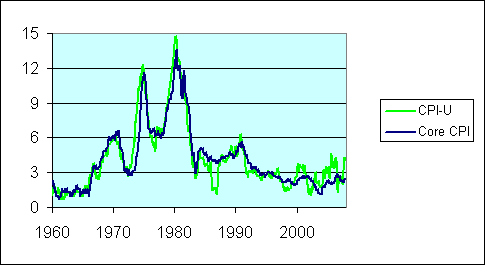 |
Tim Duy also notes that the Fed could not be cheered by the modest trend upward in the rate of inflation that consumers tell University of Michigan surveyors they are expecting for the next 12 months, now up to 3.7%.
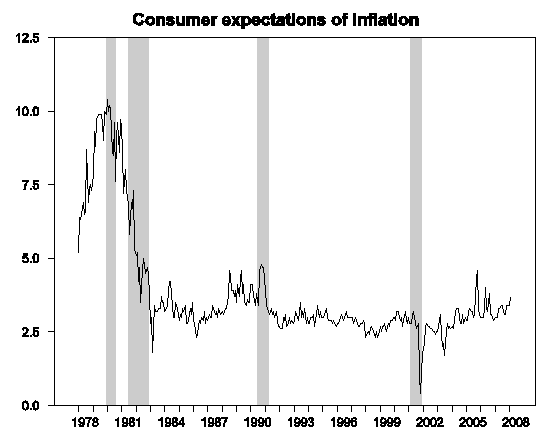 |
Then there’s the little item of those raging commodity prices over the last 30 days.

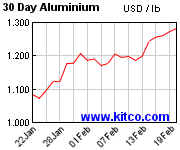

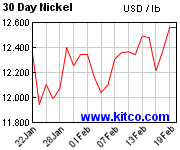
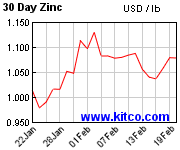
[pictures courtesy of Kitco]
The one remaining key indicator that is yet to become unmoored is the expected inflation rate implied by the gap between the yield on 10-year nominal Treasury bonds and that on bonds whose coupon and principal are indexed to rise with the CPI. This gap has remained quite stable over the last year.
 |
Greg Ip, Felix Salmon and Greg Mankiw are concerned that the 5-year TIPS-nominal spread has fallen relative to the 10 year, implying that the 5-year forward inflation rate (the so-called 5-year, 5-year break-even rate) has gone up. But I agree with the analysis by knzn and particularly
Francisco Torralba that the facts are much less alarming than Ip’s graph might have seemed to suggest, and that the basic impression of stability of longer term expectations that one brings away from the graph I’ve plotted above is the correct one.
Notwithstanding, I doubt the Fed will feel free to continue charging ahead with rate cuts on the basis of the comfort provided by this one remaining favorable indicator. Yes, the Fed will still cut another 25 basis points at its March 18 meeting. And more likely 50, if we get a dreadful employment report for February or more scares like today’s Philadelphia Fed survey. But I have to believe the Fed will be following that path down with great reluctance from this point on.
Technorati Tags: macroeconomics,
Federal Reserve,
economics,
inflation
I disagree with you completely.
I believe that Benjamin “Zimbabwe” Bernanke and his crew have examined the data you present and have concluded that “now is the time for the loosest monetary conditions in American history.” Let’s call it the “1% solution” or perhaps “the great monetary insanity.”
To borrow a current line from Hillary Clinton, “let’s get real.” BB can be summoned at will to appear in the offices of Chris Dodd and Barney Frank. He, and the institution he chairs, has lost all independence from the political process. He (and it) is little more that a political —–. (I will leave it to others to add the appropriate term.)
We will know who is right soon enough.
I too disagree with you completely and act on it in terms getting out of the US$. The Fed and BB have no credibility with me. He’ll keep cutting – its what all the elites want, as do the great unwashed if asked and its also what he wants to do. He’ll send surrogates to talk tough about inflation but that’s all. I once believed he may even not cut for one meeting just to show “he means it” but that 1.25% cut in 8 days has sealed his lack of credibility to me.
But yup, we’ll soon see.
-K
Interesting post. Inflation concerns by the Federal Reserve have taken a more prominent role as judging by recent Fed-speak. However, despite the increased level of attention inflation has received as of late, monetary policy actions addressing inflation may still be out-of-the-question. Although I don’t have the experience that comes with the time spent in and around global capital markets and the American economy (as a student) relative to yours, I still see the majority of our largest financiers exposed to risks which have not been observed in the past, ever. Addressing inflation at a time like this via rate increases could very well insure the downfall of the American economy for some lengthy future time period.
Watch the posts that will surely come. This is what happens when you make a credible commitment to being irrational about monetary policy, even when you’re not actually nuts. It’s not a card that can be played many times.
Re:Scott, I’d reiterate my belief that long real interest rates were/are artificially depressed by our foreign investors. Professor Chinn has suggested an effect around 1%. I suspect it’s larger than that, but if we were to have the same effect in reverse, our effective long real rates would double. I wonder whether their voice is being taken into account in policymaking.
Watch the price of CDS for investment grade paper, too, which continues to show an increase in spreads to silly levels. The monolines have indicated they may stop issuing such swaps, which may be artificially skewing things, but it’s more evidence of a lack of policy traction.
Taken together, I believe monetary policy is currently and will be much less accommodative than the Fed would like. They’re not really in control. String.
A comment and a question.
The ex. food and energy core inflation question has in my view been premised on an assumption of mean reversal: higher oil prices would derive from short term (one to a few years) imbalances between short run variable demand and medium to long run developing supply. They would eventually bring their own downfall as higher prices moved exploration etc. Same goes for food prices. If mean reversal is no longer a correct assumption, the core inflation concept collapses.
I have always informally taken TIPS derived inflation expectations (or other countries similar data) as an indicator not of inflation expectations, but of central bank credibility. Having been in the private forecasting business for a very long time, I do not believe that we can make five or more years inflation forecasts in any serious fashion. All that we can do is introduce (or not) in the “model” rules allowing policy to react to changes in inflation in order to control its movement. So the question is, are there papers that have tested formally whether TIPS inflation expectations are really tests of central bank credibility and not actual expectations of inflation ?
The current action in the dollar is also supportive of the Fed continuing to cut. Inflation is not being driven by the U.S. but by countries with strong growth and dollar pegs. U.S. monetary policy is a game of brinkmanship about whether the inflation being unleashed will be more painful for the U.S. or for pegged countries.
Eventually I believe the pegs will break, inflation will no longer be a problem, and the U.S. will begin a long period of adjustment where higher long-term real interest rates make for a slow recovery. If the pegs hold, debtor countries benefit, and the U.S. consumer pulls the U.S. through another close one.
The Fed continues to avoid the obvious conclusion: inflation is tied to overseas dollar reserve accumulation. It is the consequence of “exporting” our easy monetary policy to dollar-peg countries. In return, we get, first, commodity price inflation, and second, import price inflation (which by the way affects all tradeables prices, not just import prices).
There is no doubt that dollar peg countries are facing accelerating inflation. The question is how long they can tie either their monetary or exchange rate policies to ours. In the case of China, the problem is particularly acute.
The response of these reserve accumulators is likely to be revaluation. A reval would have two effects on our economy: 1) it would increase import price inflation, effectively re-exporting inflation to our shores; and 2) it would raise long term interest rates.
The Fed refuses to acknowledge the possibility of the dollar pegs breaking. This is truly an “upside risk”.
JDH,
I am probably in the minority when I cheer inflation on. As a holder of a fixed rate mortgage, inflation is helping me. Let’s say I take home $2000 per month, the P&I on my mortgage is $1000 leaving me with $1000 for other spending. If inflation runs 4%, my “other spending” would cost me $1040, but my P&I would stay $1000. If my employer gave me a 4% COLA to match inflation, I would take home $2080. Subtracting my mortgage would leave me $1080. I would have an extra $40 in spending money after accounting for inflation.
“But the changes in energy prices over the last five years have not come from temporary supply disruptions, but instead reflect longer run developments. Likewise, rising food prices are due not so much to poor harvests as to our misguided ethanol policy, which unfortunately again I see no sign of going away.”
JDH, as a bona fide energy expert, is entitled to have an opinion about the fundamentals, but as a macroeconomist with only a casual knowledge of energy markets, I’m going to make the same argument I always make about food and energy prices: if the fundamentals of food and energy are so bullish as to imply that the trend of the past 5 years is likely to continue, why is anyone willing to take the short side in the futures markets?
Excellent point, knzn. I was arguing the case not for more serial correlation in the growth rate of food and energy prices, but instead less of a tendency for mean reversion in the levels.
JDH,
Even the Fed recognizes that 10 year treas. yield minus TIPS yield may be a flawed measure of inflation expectations.
To quote the Financial Times:
http://www.ft.com/cms/s/0/1dee62e8-e0bc-11dc-b0d7-0000779fd2ac.html
Any consistent mispricing in the TIPS market should be impossible: it should be arbitraged out. This is likely one reason that the Fed continues to use the TIPS spread as an inflation expectations gauge, despite that market’s poor track record in forecasting inflation.
The question is, can arbitrage occur in the TIPS market? There is certainly an inefficiency from the tax standpoint: inflation gains are partially taxed away. Financial theory says that the marginal zero-tax investor (pension funds) with sufficient access to financing can still produce arbitrage. Is this the case? I have never heard TIPS defenders discuss whether arbitrage works in that market.
Re: my comment above, it seems clear that, in addition to taxes, TIPS are also affected by fluctuating real interest rate and liquidity premium expectations, and that either could interfere with the ability of speculators to arbitrage out the mispricing of inflation expectations.
Any consistent mispricing in the TIPS market should be impossible: it should be arbitraged out. This is likely one reason that the Fed continues to use the TIPS spread as an inflation expectations gauge, despite that market’s poor track record in forecasting inflation.
When is such idiotic reasoning going to be discarded by educated economists? The TIPS spreads DO NOT predict inflation.
TIPS investors have LOST MONEY in the past years.
TIPS investors were WRONG, and could be WRONG in the future.
Go run the numbers between the implied inflation in TIPS spreads and actual inflation in the past.
It amazes me that this omniscience is being granted to TIPS investors. That somehow they behave in a way that they would NEVER lose and they would SUCCEED all the time.
Bumble, the point isn’t that TIPS investors can’t be wrong, haven’t been wrong, or won’t be wrong in the future. The point is that (modulo technical details like arbitrage and liquidity) they can’t be KNOWN TO BE WRONG. There can’t be a market and/or social consensus that TIPS investors are badly wrong about future inflation estimates. You may have an opinion that they are wrong, but basically by definition your opinion must be in the minority, at least as weighted by ability to invest in the markets.
Bumble, I’m not sure what you mean when you say that TIPS investors have lost money. Could you please clarify?
The question here is not comparing Treasury – TIPS with CPI, but instead comparing the ex post total yield on nominal Treasuries with the ex post total yield on TIPS.
4degreesnorth, there are quite a few academic studies on what TIPS may tell us about Fed credibility. Here’s a link to one of my favorites.
the point isn’t that TIPS investors can’t be wrong, haven’t been wrong, or won’t be wrong in the future. ….
I am not debating that; what I fail to understand is why those TIPS spreads are granted sacrosanctity, and used as an INPUT into economic calculations. Since when did garbage inputs start producing valid outputs? There is a difference between “this is the market expectation of future inflation” and “this is future inflation”.
Here’s material from the Cleveland FED showing that when adjustments are made for bias, a TIPS-derived estimate of inflation expectations shows a definite surge into new territory in recent months.
http://www.clevelandfed.org/research/inflation/TIpS/index.cfm
Cleveland FED:Inflation Central :: TIPS Expected Inflation Estimates
Nice link and graph, C-. Thanks!
4degreesnorth makes a good observation. I too believe that food and enrgy prices are on a trend rise relative to other prices. As such, I regard the Fed concentration on ‘core’ inflation to be misguided. Quite frankly, I think they use it as a excuse to provide otherwise unjustifiably loose monetary policy. The federal reserve seems to have become too pliable to pressure from the financial community. Their mandate should be replaced with one that makes them responsible for price stability, and nothing else.
don:
Agree completely with your last sentence. And so does the ECB and the vast majority of other central banks.
But unfortunately, it is the USA that suffered the ill fate of being the home of Augustus Hawkins, the original motive force behind this asinine dual mandate.
The US dual mandate is something like charging an institution with promoting “compensated dating” and celibacy simultaneously.
It is only possible within the convoluted verbal gymnastics that pump out endlessly from our FOMC members.
Inflation Expections
I once heard an explanation of why economics is termed “the dismal science”. It’s because, you see, you can spend ten years of your life, full-time, working on a particular model of something … capturing inputs, backtesting…
And quite impressive verbal gymnastics from you too esb…don’t expect me to follow suit…I won’t do it, the contagion stops here!
Lots of interesting stuff on inflation (thank you JDH for those graphs…and “unwelcome developments”, but for phrases that stick in one’s mind, this one: “but gee, they seem pretty darn close.” I’m sure I’m going to blurt out the next time I’m pulled over for speeding.) here but little on stagnant wages… the other half of “stagflation”, yes?
You suppose that inflation can careen off like that (“unwelcome developments”) while wages..well, like GM does…
So vastly inflated views of the pernicious, malignant and dastardly peril of Perils: inflation.
Gotta verbal somersault with esb, you?
calmo:
Actually, I have a suggestion for the BLS.
A new index to be called CPI-N, where the “N” references necessities.
Because it is the necessities that are (and are going to be) the focus of suffering for many of our fellow citizens, possibly for most of them.
Inflating necessities and wages that cannot keep pace … the perfect solution to our “mess” from the boys and girls in the Marriner S. Eccles Building.
I can understand the misguided frustration most of us seem to be dealing with when it comes to inflation and it’s expectations because most of us do not realise that the cost of living is going up around the world no matter what we think or say. You can put the blame on any number of environments that you like and it will still mean it will cost us more to live. This is part of an adjustment of world proportions and I expect that the cost of living will increase 1.5 to 2 percent and possibly more depending on the country you might live in. It is called reflation a combination of recession and inflation. There has been an adjustment in world economics to share more of the burden for living and that is it.
The Fed has little choice but to move the bar on inflation. The public and private sectors are awash in long term debt on over-priced assets. A depression is a one outcome from a sudden collapse of the debt bubble. The choice lies somewhere between inflating away the debt and the dollar denominated asset price disparity or collapsing the whole enchilada in a puritanical purge. The Fed is up to their eyeballs, through bad policy and lax regulation, in creating the mess. The question becomes: Are they competent to guide the mess away from the “stable disequilibrium” toward a more sustainable economy ?
In the old days, the rate of growth in inflation was only reduced by a reduction in GDP growth or a recession. The new fangled economics would have us believe that inflation can be reduced without inducing recession by introducing deflationary, competitive counterforces like foreign labor.
But whoops, this ultimately creates a deflationary domestic economy, accompanied by recession (2001), that must be stimulated by lax monetary policy. But whoops, that creates inflation which is exported to the deflationary, competitive counterforce economies and can only be reduced through recession.
An industrial process controller outputs a response that is proportional to the deviation between the process variable and the set point. A second order, integral function, adjusts the proportional band to eliminate offset when the proportional output is unable to restore the process to the set point. If the integrative function is not tuned correctly, the process becomes unstable, gyrating wildly between too much and too little.
Fed policy is both the proportional and integrative functions. I would say both have been terribly out of tune. We better call the intstrumentation engineers at the Fed.
What happened to the informal 1% to 2% target band?
zinc:
I think of a bear, tiptoeing from trap to trap, convinced that none of them will ever “spring.”
Now think of the following …
The titular head of our central bank is summoned to the offices of a Senator.
Following the meeting, the Senator walks out and tells “the people” what the central banker has been told to do.
And then the central banker goes home and, well, just does it.
And then a couple of months later, the process repeats.
Why is it that free marketeers are looking at the FED or congress to “fix” this problems when the markets if not messed with will fix in a swift manner?
Anon: finally a question I can answer! As with our over-medication for all sorts of ills in this country, it is thought that we no longer can (or should) tolerate any kind of pain. Or so our gubmint thinks.
Because the “Market”(please, never use “free”, when that doesn’t exist in nature) fix WILL be painfull and alot of powerfull people will be in trouble.
That is why the Gov. doesn’t want to see anything go bad. Ditto for capitalists and financial critters of the filth.
The problem is, they have no way out unless some BAD pain will be felt by JSP and the parade of idiots.
As my grandfather said: Well, after the 30’s debacle, it was said, this would NEVER happen again. Sadly, history likes to repeat itself.
Historic price movements (up) are still occuring in agricultural prices. See the remarkable price chart for the March spring wheat futures contract today at the Minneapolis Grain Exchange:
http://www.mgex.com/quotes.html?page=chart&sym=MW
While this is a small market, it is further and dramatic evidence of the price pressures in commodity markets.
What I don’t hear much about is: IF inflation is going up and GDP expansion is slowing, then all the talk about insufficient aggregate demand is secondary against the possibility of a supply shock.
Higher credit cost, higher (physical) input prices , higher labor costs (with inflation in China and rising import prices thanks to the weak US$)… a slowing of AS expansion sounds plausible. And if that is the case, then policy aimed at expanding the AD can backfire mightily.
Just some meet-and-potatoes intermediate macro in action:
http://mykernelmynull.blogspot.com/2008/02/ad-vs-as.html